Georgia (Country) Road Trip: My Adventurous 10 Day Itinerary
29 min readMy complete 10-day itinerary for an adventurous Georgia (country) road trip from Tbilisi to Batumi. Includes recommended stops, times and distances, and driving tips.
Back in summer 2020 – six months after I moved to Tbilisi from Australia – I hired a car in Georgia and drove myself (and my husband, Ross) around the country for the first time.
It was an unforgettable trip, and the start of my unlikely love affair with driving in Georgia. (After renting cars for the past four years, Ross and I just bought our own!)
Since then, we have done a dozen more road trips in Georgia, exploring different regions and criss-crossing the country to scout out the best routes.

The 10-day itinerary I have designed is perfect for return visitors and offbeat travellers. It hits on many of the must-sees (including six regions and three of Georgia’s four UNESCO sites) while focusing on more remote and obscure destinations that you simply can’t do justice without a car.
It avoids the main highways (including the new Rikoti Pass) and follows scenic detours and village backroads instead. It packs a lot in, but it also includes a couple of quieter days for exploring Meskheti, Racha and Guria – three of the most underrated regions.
This itinerary can be done in spring, summer or autumn, and it does not require a 4WD or any special driving skills. At the end, you will find four route modifications that you can use to add other destinations to your itinerary.
If you’re not afraid of getting off the beaten path, here’s how you can see some of the country’s most dramatic passes and loveliest small villages, discover heritage monasteries and hidden treasures from Soviet times, and immerse yourself in Georgia’s tea history.
While I am a big advocate of self-driving in Georgia, I understand that it’s not for everyone. I have a separate Georgia travel itinerary using public transportation that is suitable for those who prefer not to hire a car.
Please note: This post contains affiliate links, meaning I may earn a commission if you make a purchase by clicking a link (at no extra cost to you). Learn more.
Places visited on my Georgia road trip
Here is a quick summary of the main places you will visit. There are many more stops included in the detailed itinerary below.
- Mtskheta — Georgia’s old capital & a UNESCO World Heritage Site
- The Didgori Battle Memorial — a breathtaking monument & one of the country’s most scenic drives
- The Javakheti Plateau — the lesser-visited lake district
- Vardzia — Georgia’s biggest & most impressive cave city
- Saro & ancient Meskheti Region — castles, megalithic ruins & unique cuisine
- Borjomi — mineral water springs & Romanov history
- Zestafoni, Chiatura & Sachkhere — mosaics, cable cars & other relics from the Soviet period
- Katskhi Pillar — the iconic monastery perched atop a limestone column
- Racha-Lechkhumi Region — an alternative mountain region for hiking & wine
- Kutaisi — Georgia’s fourth-biggest city & unofficial capital of culture
- Tskaltubo — semi-abandoned Soviet spas & sanatoriums
- The Mosaic Route — sanatoriums, Culture Houses, mosaics & monuments
- Guria Region — tea country
- Kolkheti National Park — the UNESCO-listed wetlands
- The Black Sea Coast — black-sand swimming beaches & seafood
- Batumi — quirky architecture on the Black Sea


The new Rikoti Highway
To the best of my knowledge, this is the only free Georgia driving itinerary available online that accounts for the new highway between Tbilisi and Batumi.
The Rikoti Highway includes 97 new bridges and 51 new tunnels. Around 70% are now open, with additional stages set to come online throughout summer 2024.
While the new highway is excellent for travelling efficiently from one side of the country to the other, the ‘scenic route’ through the southern part of Georgia is much more rewarding.
If you follow my alternative itinerary, you will skip the partially finished Rikoti Highway (and its constant roadworks and closures) and get to explore what is altogether a lesser-visited (and in my mind, much more beautiful) part of the country.
It does involve a bit more driving on the first day, but it is more than worth the extra time behind the wheel.
What about Tbilisi?
There is no reason to drive in Tbilisi – in fact, having a car in Tbilisi is more of a liability than anything. I recommend spending time in the capital when you first arrive in Georgia and only hiring a car for the days you spend outside of the city.
For most travellers, 2-3 full days in Tbilisi is ample time. Use the bus and metro network to get around, or simply explore the Old Town core and its many different neighbourhoods on foot.
→ Discover 51 of the best things to do in Tbilisi in my city guide.

What about the wine region?
Visiting Georgia’s main wine region, Kakheti, is a highlight of any trip to Georgia. Because it revolves around vineyards and cellar doors – free-pouring is the norm at wine degustations! – I don’t generally recommend self-driving in Kakheti.
If you are seeking a wine experience, it is a better idea to do a dedicated wine tour from Tbilisi. If you do have a designated driver in your party and still wish to include Kakheti on your road trip, you will find an option to add the Wine Route at the end.
My itinerary visits an alternative wine region in Racha and includes opportunities for wine tasting in Imereti and Guria.
→ See my Kakheti itinerary for more ideas.
What about the mountains (Kazbegi, Svaneti, Adjara)?
Georgia’s mountain roads are the most challenging in the country. Many factors come into play here: infrastructure and upkeep, weather, and in the case of the Georgian Military Highway, traffic and trucks.
My itinerary visits Racha, an alternative mountain region that is popular among Georgians but lesser known to international visitors. I like this area because it is much quieter and the roads are easy to navigate.
If you want to add Mestia, Kazbegi or Khulo to your Georgia itinerary, you will find optional extensions at the end. I only recommend self-driving to these areas if you are an experienced driver. It is best to hire a 4WD.
→ For 4x4s and off-roading vehicles, I recommend hiring from Martyna z Gruzji (mention me to get 10% off your rental).

Best time for a driving holiday in Georgia
My itinerary can be done any time between May and November.
Spring and autumn are generally the best times of year to visit Georgia. I recommend driving in late May/early June, or in late September/October. Temperatures are pleasant, it is less crowded, and you will be treated to either blossoming spring wildflowers or beautiful fall foliage.
Renting a car in Georgia
Local Rent is my go-to for car hire. I have used the platform more than a dozen times now in Georgia and in Albania, and it is always a smooth process.
Local Rent differs from larger companies in that it sources cars directly from local agents. Prices are generally much lower – from 35 USD a day.
Most agents do not require a cash deposit or a credit card. The only thing you pay in advance is a small online booking fee, which is refundable. The balance is settled in cash when you pick up the car.
Provided your licence meets the requirements, you do not need an International Driving Permit. All you need is your driving licence and ID (passport). Insurance comes included.
You can choose to pick up your car anywhere in the city of origin. The agent will literally deliver the car right to your front door (or to a convenient rendezvous point). The same goes for drop-off.
While this itinerary does not necessarily require a 4WD, it is not a bad idea to take a one. When I drive in Georgia, I usually hire a Pajero or similar. A car with high undercarriage clearance is always a good idea.

5 quick tips for a successful road trip in Georgia
In Georgia, you drive on the right-hand side of the road. Road signs are all in English (or Latin characters), and there are no toll roads.
1. Get an early start — For the most part, the roads are much quieter in the morning (before 10am).
2. Do not drive in Tbilisi — Pick up your car on the outskirts of the city. Local Rent gives you the option to collect your car from any address.
3. Stay on top of the weather & road closures — Conditions can change rapidly, especially in the mountains. Always check locally before you set off, and use the GeoRoad Facebook Page or hotline to stay on top of closures.
4. Be wary of aggressive drivers — Overtaking on single-lane roads is common. The driving style in Georgia is generally pretty haphazard and does take a bit of getting used to. But in my experience, the roads in Georgia feel far worse when you’re a passenger/pedestrian. When you’re behind the wheel, it’s not so bad – especially if you avoid driving in bigger cities.
5. Use Google Maps for navigation — Pick up a local SIM card or eSIM when you arrive. There is no need to hire a GPS unit. It’s a good idea to add on 25-50% more time than Google Maps predicts (to account for traffic, photo stops and the like).
→ More driving tips and information about hiring a car in Tbilisi
Georgia road trip itinerary: Detailed day by day
Here’s a detailed breakdown of my Georgia road trip itinerary, including drive times, road conditions, things to do in each town/city, and where to stop along the way.
Day 1: The Javakheti Plateau
Distance: 220 km (137 mi) | Total drive time: 5.5 hrs plus stops

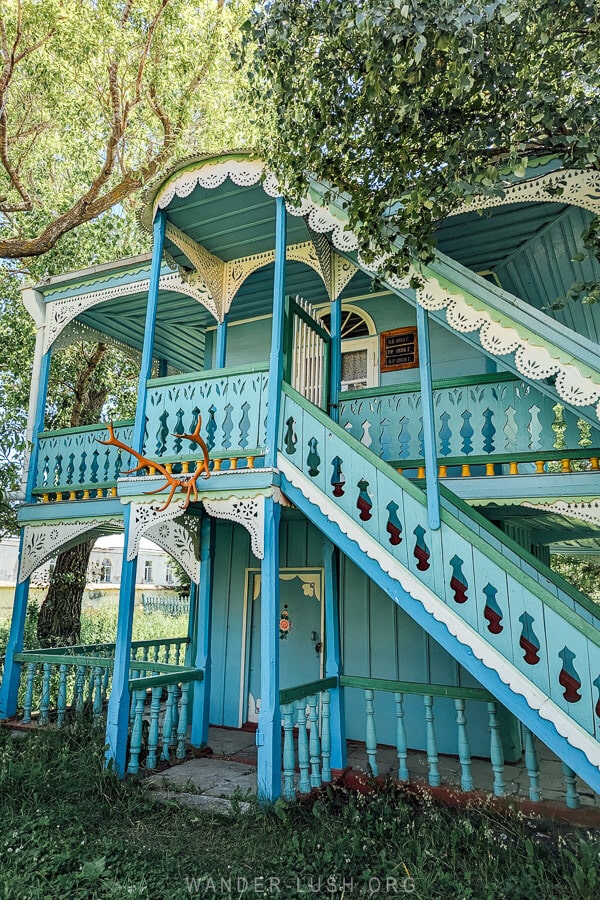

Today’s highlights:
- Mtskheta Jvari & Manglisi Sioni
- Driving the scenic road to the Didgori Battle Memorial
- Searching for petroglyphs in Tsalka
- The Poka St. Nino’s Convent shop
- Birdwatching on Bughdasheni Lake
- Learning about Doukhobor culture in Gorelovka
Day 1 of this itinerary is the longest drive by far. You won’t regret hitting the ground running, though. The roads in the south are usually pretty quiet, meaning you can still ease into the driving style at your own pace.
I recommend getting your car delivered to Dighomi so that you don’t have to drive through the centre of Tbilisi. When I did this road trip, I chose an address just off the highway (this restaurant) so that it would be easy for me to get straight onto the highway. This strategy worked really well.
On your way out of Tbilisi, you have an opportunity to stop in Mtskheta to visit Jvari Monastery and Svetitskhoveli Cathedral, part of the UNESCO-listed Ancient Monuments of Mtsketa. But if you are particularly interested in monasteries, then I recommend using one of your days in Tbilisi for a half-day guided trip to Mtskheta and heading directly to Didgori instead.

The Didgori Battle Memorial is a sculptural complex in the Didgori Valley, 60 minutes’ drive from Tbilisi via an incredibly scenic, newly tarred road. It marks the location where King David the Builder defeated the Suljuk Turks in the Battle of Didgori, ushering in the unification of Georgia and the nation’s ‘Golden Age’.

After walking around the complex, continue driving south towards Manglisi. One of the oldest churches in Georgia (the original structure was dated to the 4th century), Maglisi Sioni is worth a quick stop. (Ignore Google Maps when it says the church is permanently closed.)
There is a lot more to see and do in Kvemo Kartli Region, including hiking in Algeti National Park, Birtvisi Canyon and Samshvilde Canyon, as well as the old Swabian German villages of Asureti and Bolnisi.
But time is of the essence, so I suggest you continue west to Tsalka, a small town located on an artificial reservoir – the first of many lakes you will see today. In Tsalka, you can stop for lunch at the Pontic Greek restaurant Pontia, take a quick hike to track down the Mesolithic Petroglyphs, or drive out to Trialeti, another German colony with an old Lutheran Church and fachwerk houses.
The new Diamond Bridge in Tsalka Canyon (Dashbashi Canyon) is tacky and overpriced and not worth visiting in my opinion.

Spend the rest of the afternoon touring Javakheti, an elevated volcanic plateau dotted with gemstone lakes. On the shore of Paravani Lake – the biggest lake in this region – you will see the ruins of a Silk Road caravanserai. Poka St. Nino’s Convent at the southern tip has a pretty church overlooking the water and a terrific shop where you can buy jams, chocolate truffles and natural beauty products hand-made by the resident nuns.
Take a short detour towards the Turkish border for Bughdasheni and Madatapa, my two favourite lakes. The former is small enough to walk around, while Madatapa is always teeming with birdlife.
→ For more tips and things to see, refer to my Tsalka and Javakheti Guide.
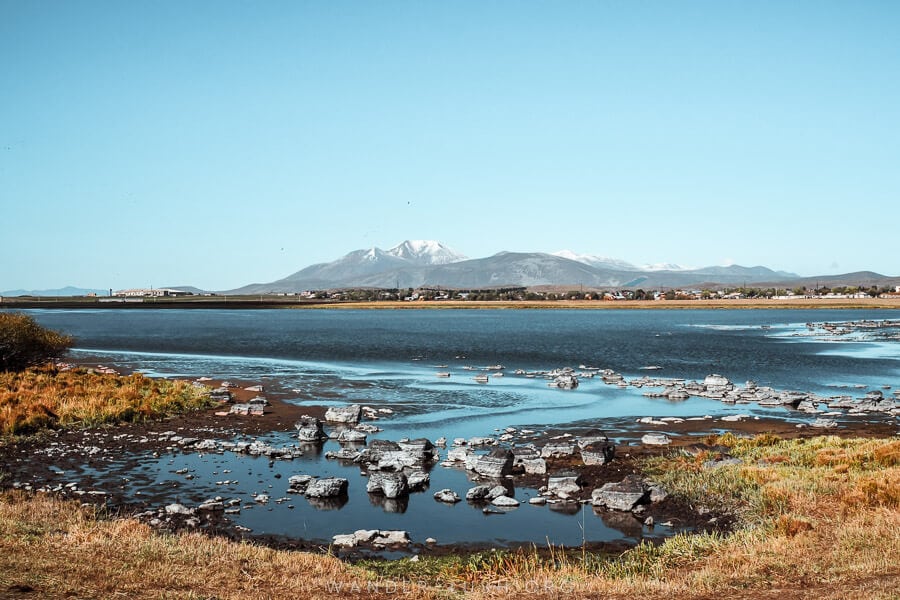
Gorelovka is one of the half a dozen villages in this area settled by Doukhobor families exiled from Russia in the early 20th century. The gates to their turquoise-blue Prayer House are often unlocked, permitting visitors to walk the grounds. I have been lucky enough to go inside the Prayer House on two occasions.
Please remember that this is a sacred place that should be treated with respect.

If you have the energy (and enough daylight), I recommend you drive another 90 minutes and spend the night at Vardzia Resort before waking up early the next morning to visit the caves. If you prefer to call it a day, the town of Ninotsminda is 15 minutes’ drive from Gorelovka and has a wonderful family run hotel (Hotel Sonya) that is more than adequate for a night’s rest.
Day 2: Vardzia, Akhaltsikhe & Meskheti
Distance: 100 km (62 mi) | Total drive time: 2.5 hrs plus stops



Today’s highlights:
- Georgia’s biggest cave city, Vardzia
- Hiking to the megalithic ruins in Saro village
- Khertvisi & Tmogvi Fortresses
- Qvevri beer tasting at Amphora Beer
- Visiting Akhaltsikhe Castle (Rabati Fortress)
- Traditional Meskhetian cuisine in Akhaltsikhe
- Drinking Borjomi mineral water direct from the spring
If you decide to stay in Ninotsminda on day 1, get up early to drive to Vardzia. I recommend arriving at the cave city first thing in the morning when gates open at 10am.
Composed of 300 rock-hewn chambers arranged over 13 levels, Vardzia is a vast complex. It takes approximately 2 hours to walk the marked paths and explore the various chapels, nooks and crannies. I highly recommend the audio guide.
→ For more tips and tricks, see my Vardzia Visitor’s Guide.

On your way out of Vardzia, stop at this viewpoint for a nice panorama of the entire cliffside. The drive back to the main road along the Mtkvari River is absolutely spectacular – look out for watchtowers perched high on hilltops, and terraced vineyards cut from the riverbank. Khertvisi Fortress recently reopened to the public and it is worth stopping to go inside.
Travel north for another 7 kilometres then take the turnoff for Saro, following the new road up to the village. Saro is one of my favourite places in Meskheti region.
Park outside the Archangel of Saro Church and greet the nuns (say hello to Teona for me!) before walking out to the plateau and examining the lichen-covered megalithic ruins. If you have time, you can follow the marked hiking trail down to Nijgori and back. The scenery is breathtaking.

There is an option to stop at Amphora Beer on your way up to Akhaltsikhe. This family run brewery and beer spa (yes, really!) has half a dozen different ales on tap, all made in-house using local hops and fermented in the same clay qvevri traditionally used for wine.
In Akhaltsikhe city, prioritise visiting Akhaltsikhe Castle (AKA Rabati Fortress) and the exceptional Samtskhe-Javakheti History Museum located on its grounds.
Just across the river, Old Bar has an entire menu dedicated to Meskhetian delicacies that are tricky to find outside of this region. I recommend trying the apokhti khinkali (dumplings filled with dried meat), the local khachapuri (made with crispy pastry) and the lokokina (Georgian-style escargot!).
→ For more things to do, see my Akhaltiskhe Guide.

From Akhaltsikhe, you have another hour of driving – past more fortresses and mosques – to reach Borjomi. If you arrive in the late afternoon, you will have time for a stroll through the Central Park where you can drink the famous mineral water direct from the original Romanov-era springs. Cafe Iggy is a fine option for dinner.
→ For more things to do on your evening in Borjomi, see my Borjomi Guide.
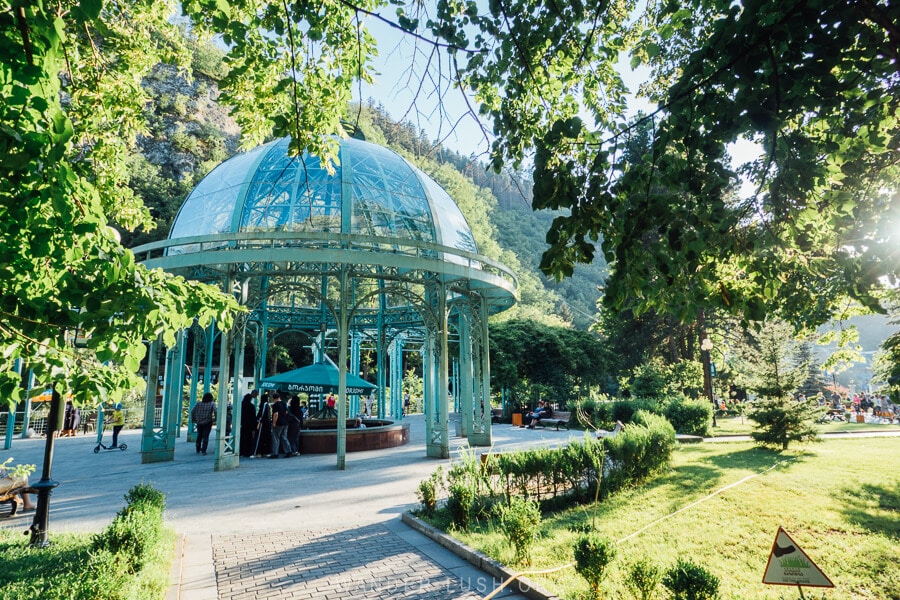
Overnight in Borjomi at Golden Tulip.
Day 3: Chiatura, Zestafoni & Katskhi Pillar
Distance: 130 km (81 mi) | Total drive time: 2.5 hrs plus stops



Today’s highlights:
- Surami Fortress
- Soviet-era mosaics in Khashuri & Zestafoni
- Photographing the spectacular Katskhi Pillar
- Riding the cable cars in Chiatura
Today’s drive takes you from the mystical south to the mountainous north. You will be crossing the Rikoti Pass and entering into Western Georgia proper.
Departing from Borjomi, follow the river north to join up with the main east-west highway at Khashuri. This small city is a pit-stop on the highway and the railway line and is known for producing hammocks, which you will see at small shops all along the roadside.
Nearby, Surami is a small town that dates back to the Bronze Age. There are a couple of sanatoriums here that were founded in the Soviet period when Surami was used as a treatment facility for children suffering from tuberculosis.
Climb up to the top of the 12th-century Surami Fortress for a view over the plains. This castle has a fascinating myth attached to it – you can learn all about it by watching The Legend of Surami Fortress, a 1985 film by the beloved Tbilisi-born director Sergei Parajanov.


Whilst in Surami, grab a piece of nazuki, a sweet bread that is made in the same clay oven as shotis puri only it is brushed with a sugary glaze and has raisins mixed through (it sort of tastes like a giant hot cross bun). There are dozens of roadside bakeries that sell this Surami specialty.
Whenever I come through here with a Georgian driver, they always take me to Nazuki by Sergo – apparently it’s the best!

Join up with the new highway briefly and head west towards Zestafoni. Developed in the Soviet period around a massive ferroalloy factory (which is still working, by the way – I got a chance to tour the 1930s facility a couple of years ago), Zestafoni is brimming with interesting architecture and mosaics. The Zestafoni Bazari is one of the most photogenic markets in the country.
→ Use my Zestafoni Guide to plan a walking route through the industrial city. An hour is all you need for the highlights.

After Zestafoni, leave the highway and make a right onto the Gomi-Sachkhere Road to venture deeper into the mountainous part of Imereti Region. After 40 minutes or so you will reach Katskhi Column, the iconic monastery perched atop a lone limestone pillar in the forest.
A new road permits easy access to the viewpoint, and from there you can continue on foot to the chapel at the base of the pillar. Note that climbing up to the monastery is strictly forbidden.
The rest of your day can be spent in the small city of Chiatura, starting with a home-cooked meal at the lovely Lunch at Lia (advanced reservations required). Ride the new cable cars, search for the old Brutalist stations and Soviet-era gondolas, visit the local museum, and take a long walk around town.
→ See my detailed guide to Chiatura for more suggestions.

Overnight in Chiatura at Butichi Guest House.
Day 4: Oni
Distance: 73 km (45 mi) | Total drive time: 2 hrs plus stops


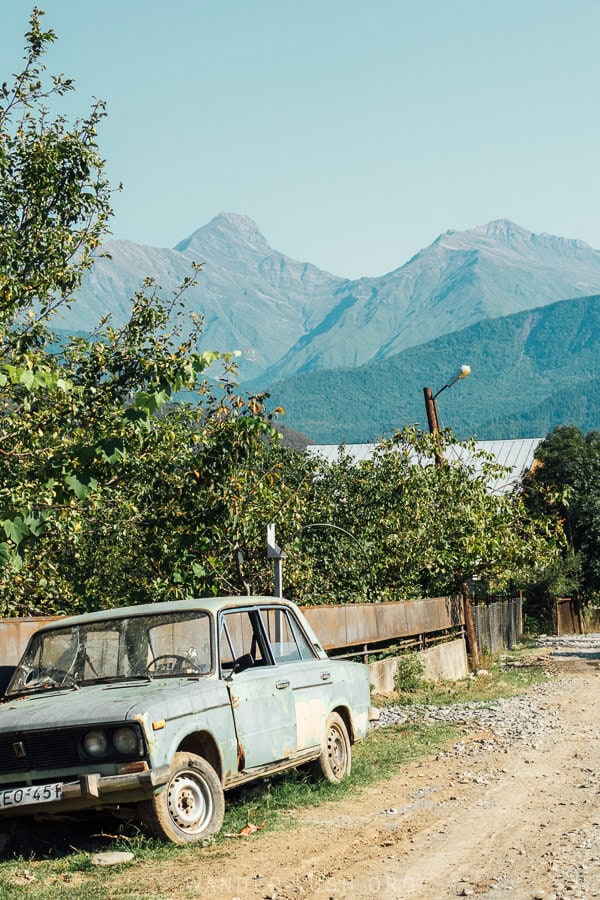
Today’s highlights:
- The cliffside Mgvimevi Convent
- Driving the scenic Sachkhere-Zudali Road
- Visiting one of Georgia’s oldest synagogues in Oni
- Panoramic views of the Greater Caucasus mountains
- A home-cooked dinner at Family Hotel Gallery
Today is all about the mountain scenery. The drive time is relatively short, leaving you with a full afternoon and evening to enjoy your guesthouse in Oni.
Leaving Chiatura, make a quick stop at Mgvimevi Convent to see the monastery pressed into the cliff wall. Sachkhere is just up the road and features a couple of beautiful Soviet-period mosaics on the way in. I highly recommend taking the time to drive out to Modinakhe Castle, a recently restored fortress with a new road and panoramic views of the Imeretian countryside.

Sachkhere is the starting point for the Sachkhere-Zudali Road, which was only completed a couple of years ago. It vies for the title of the most scenic road in Georgia – only not many people know about it! I have driven it multiple times now and always find it empty.
The 50-kilometre, switchback-rich road links Imereti with Racha-Leckhumi Region, passing pretty villages and lush forests along the way.

Oni is the first major town you come to when the highway ends. Once home to Georgia’s third-largest Jewish community, it is dripping with history. Their legacy lives on in the divine Oni Synagogue, which shines like a gem on a quiet suburban street. Built in the 1880s by a Polish architect and skilled labourers from Thessaloniki, it is one of my favourite pieces of architecture in Georgia.
A full afternoon can easily be spent wandering the streets of Oni and visiting the Local Lore Museum. Relax at the delightful Family Hotel Gallery ahead of a home-cooked Rachan dinner by the fireplace (put in a special request for shkmeruli, the garlic chicken dish that is a specialty here). Or follow one of the short hiking trails through the forest behind the house (host Nika will direct you).

If you prefer, you can hop back in the car and drive further north-east into the Greater Caucasus. When I first visited Racha, I ventured as far as Shovi, an old resort town that is home to the infamous ‘Stalin’s Dacha’. In all likelihood, Stalin never once set foot in Racha, so the name is a misnomer!
Parts of Shovi are now off-limits following the tragic mudslide that occurred in summer 2023. The lower villages of Glola and Utsera boast amazing mountain scenery and are easier to access.
Weather conditions change rapidly in this part of Georgia, and some years the entire high road washes away in spring or early summer. Always ask locally in Oni before you set off.

Overnight at Family Hotel Gallery.
Day 5: Racha-Lechkhumi
Distance: ~ 80 km (50 mi) | Total drive time: ~ 3 hrs return


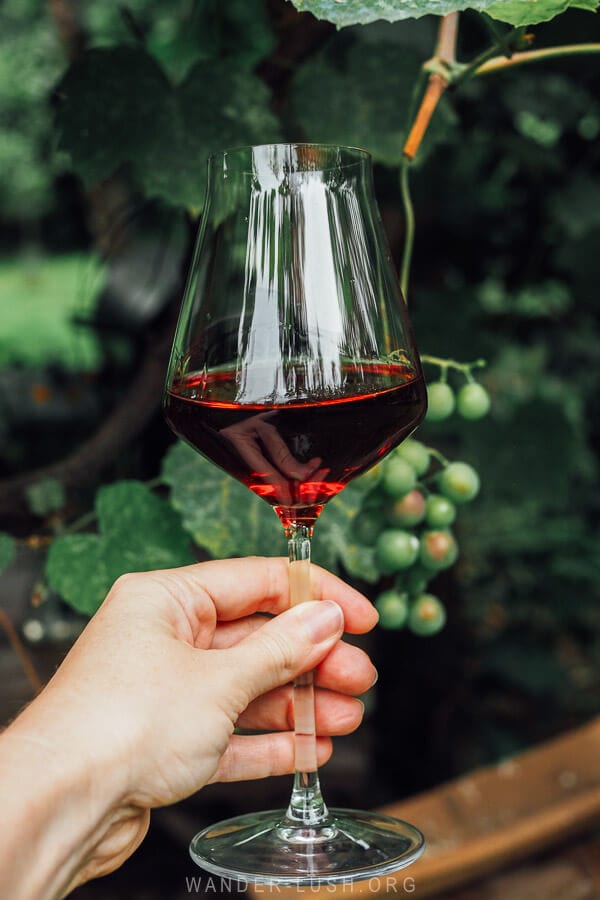
Today’s highlights:
- Hiking to the Sairme Pillars
- Swimming in the Lailashi Secret Pool
- Traditional Rachan fare at Tchrebalo Wine Cellar
- Khvanchkara wine tasting
Spend day 5 exploring more of Racha-Lechkhumi, the ‘alternative’ mountain region that most tourists tend to overlook. I think it is one of the most beautiful places in Georgia – there are hiking trails, cute villages, and Racha has a great wine region with multiple vineyards that offer tours and tastings.
Pass through Ambrolauri (you will be visiting the main town tomorrow) and head further west into Lechkhumi. The terrain here is all limestone pillars and canyons, twisting streams and spectacular passes. At certain points, the road cuts under giant boulders, making you feel as though you’re driving through a stone tunnel.
One of the best ways to immerse yourself in the landscape is by following the easy hiking trail to the Sairme Pillars. Find a map here on Wikiloc.
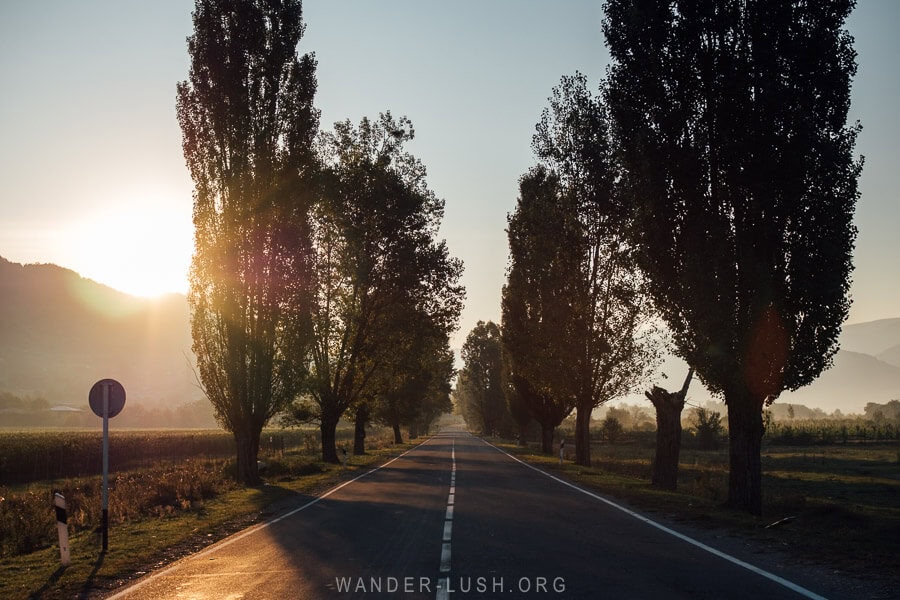
Further west, Lailashi is a fascinating village with a Silk Road connection and a synagogue of its own. The Lailashi Secret Pool (or Okronishi Fountain) is a high-altitude, natural coldwater swimming pool perched in the mountains. Note that the road up to Lailashi is unpaved and requires a robust vehicle.
On the way back to Oni, stop for lunch at the wonderful Tchrebalo Wine Cellar.

You will no doubt notice the vineyards hugging the roadside as you drive through this region. The most famous wine produced here is Khvanchkara, a sweet red made from a blend of two local grapes.
I highly recommend doing a wine degustation in the afternoon, either at the Royal Khvanchkara commercial winery in Ambrolauri, or better still at one of the small family cellars in Khvanchkara village. Nika’s Rachan Winery comes highly recommended.
→ For more to do in Racha, see my full Racha guide.
Return to Oni for a second night at Family Hotel Gallery, or stay in Ambrolauri to save yourself a bit of time tomorrow morning. I recommend Sadmeli Winery.
Day 6: Ambrolauri & Imereti
Distance: 80 km (50 mi) | Total drive time: 2 hrs plus stops



Today’s highlights:
- Nikortsminda Cathedral
- Hiking Tskrajvari
- Touring the UNESCO-listed Gelati Monastery & Motsameta Monastery
- Imeretian cooking masterclass in Gelati village
Today you will leave the mountains of Racha behind and head to Kutaisi, Georgia’s fourth-biggest city (and my adoptive home!) – but not before stopping in Ambrolauri, Racha’s main town.
Grab a lobiani (bean-stuffed pastry – another Rachan specialty) to go from Iline Bakery, then wander down the path to visit Barakoni Church of the Mother of God, an 18th-century church with a gorgeous wooden iconostasis. Ambrolauri itself is very small, but it does have the wine factory and a Museum of Fine Arts.

To reach Kutaisi, you will be following the scenic Kutaisi-Tkibuli-Ambrolauri Road, which cuts through the green heart of Imereti. A 20-minute drive south brings you to Nikortsminda Cathedral, widely considered to be one of Georgia’s most beautiful (including by UNESCO, who have named it a Tentative World Heritage Site).
Built between 1010–1014, the stone engravings on the facade are incredibly intricate, but it’s the 17th-century frescoes inside that are really special.

A few minutes further down the road, Shaori Lake is an artificial reservoir enveloped in a forest that is popular for swimming and fishing in summer. If you are here in autumn, you will definitely want to stop to admire the fall colours and crunch through the leaves.
Just after the reservoir, you will cross the Nakerala Pass where there is a marked viewpoint. For a really stunning panorama, take the exit after the viewpoint and follow the sealed road towards Tskhrajvari or the Hill of Nine Crosses. Park near the abandoned cable car station and continue on foot, taking care to navigate the paths and steep steps that lead to a tiny peak decorated with crosses and a small chapel. The hike is short, but it does require good shoes.
→ See my Guide to the Tskhrajvari Hike for more insights.
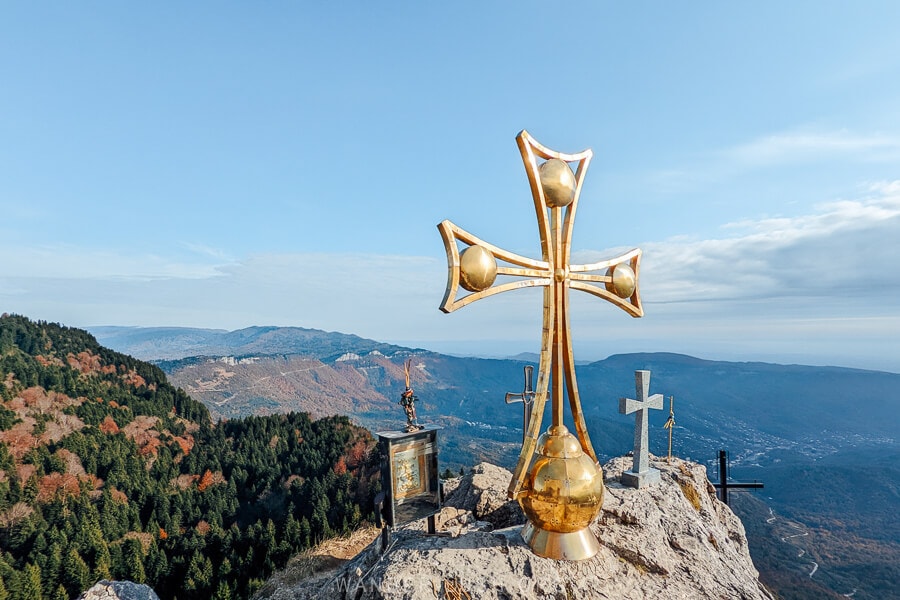
The remainder of the drive towards Kutaisi (around 75 minutes in total) is along a quiet, rural road. You will be passing directly by Gelati Monastery and Motsameta Monastery, so I recommend stopping now to visit both before you hit the city (rather than coming back as a side-trip like most people do).
There are a few excellent eateries in this area. Agro Guesthouse Korena offers supra-style spreads and cooking classes, where Dali Bebo (Grandma Dali) will teach you the ins and outs of cooking Imeruli khachapuri and other local goodies using clay ketsi pots set on the hearth.
Pre-book via Facebook and enjoy a masterclass and/or dinner in the village before heading down to your accommodation in Kutaisi (15 minutes’ drive) for the night. If you prefer to stay outside of the city, Agro also offers beautiful guest rooms.
Day 7: Kutaisi & Tskaltubo
Distance: ~ 15 km (9 mi) | Total drive time: ~ 1 hr return



Today’s highlights:
- Morning at Kutaisi Green Bazaar
- Walking tour of Kutaisi city
- Exploring the semi-abandoned sanatoriums & spas in Tskaltubo
- Sunset at Bagrati Cathedral
Start your morning at the thronging Kutaisi Green Bazaar, where fresh herbs are in no short supply, before embarking on a self-guided walking tour of the city. Kutaisi is petite and very walkable, with a French-Catholic Quarter, a Jewish Quarter, and a gamut of interesting small museums.
→ See day 1 of my Kutaisi Itinerary for specific points of interest.

After lunch in the city at Doli, Gala or another Kutaisi restaurant, make the 20-minute drive out to Tskaltubo. Developed as a balneological resort in the Soviet era, Tskaltubo was once serviced by direct trains from Moscow and was a favourite place for the party elite (including Stalin himself) to exercise their ‘right to rest’. Visiting Tskaltubo is like travelling back in time. It is my favourite place in Georgia.
→ My comprehensive Tskaltubo Guide contains a full list of sanatoriums plus a map and a list of locations to prioritise.

If Tskaltubo is not of interest, you could head further west into Samegrelo Region to visit the caves and canyons instead.
Either way, I recommend returning to Kutaisi in time to walk up to Bagrati Cathedral and watch the sunset from the churchyard. Finish your day with a glass of Imeretian wine at Winetage, which is my favourite bar in Kutaisi.
Day 8: The Mosaic Route, Poti & Kolkheti National Park
Distance: 150 km (93 mi) | Total drive time: 3 hrs plus stops



Today’s Highlights:
- Soviet-era Culture Houses, mosaics & monuments on the Mosaic Route
- Abandoned sanatoriums in Menji
- Senaki Theatre
- Climbing the lighthouse in Poti
- Taking a boat ride across the marshes in Kolkheti National Park
Day 8 takes you further west all the way to the Black Sea Coast (briefly) before ducking back inland to spend some time in Guria, Georgia’s smallest region and the heart of tea country.
On the way out from Kutaisi, you can visit several small towns located along the highway. I have dubbed this stretch ‘The Mosaic Route’ because of all the pannos, monuments, Culture Houses and other relics from the Soviet period that are dotted around.
First stop is the former Culture House in Marani village just outside Samtredia. It is one of several that is currently undergoing restorations and will (hopefully) be returned to its former glory, or at least its former function as a community centre.

Abasha village also has a Culture House, but it’s the eye-catching sculptural complex and patchwork quilt-like mosaic by Vakhtang Nodia near the Municipality City Hall that are worth stopping for. Several more decorative walls and bus stops can be seen along the highway between Abasha and Senaki.
Senaki has several mosaics and an incredible theatre that was built in 1953-1959 and modelled off The Hermitage. Stop for a brief walk through town, and don’t miss the eerie WWII Memorial located in the park behind the theatre.

Just past Senaki, there are several hauntingly beautiful abandoned sanatoriums in the village of Menji, including one with an impressive dome. Also stop at the former military settlement near Senaki Airbase to see this memorial.

From Senaki, it takes another 40 minutes to reach the coast. Your first encounter with the Black Sea will be in the port city of Poti, dubbed ‘Little Paris’ for its gridded layout. You will need to summit the stairs at Poti Lighthouse to fully appreciate the European-style city planning. Then you can wander the streets around the Kolkheti Culture Museum (also worth visiting) to see some beautiful examples of period architecture.
Bristol Restaurant is an excellent spot to order a few Mingrelian specialty foods for lunch – I recommend the kharcho beef and walnut stew with elarji, and the local khachapuri.
→ Find more things to do in Poti in my Poti City Guide.
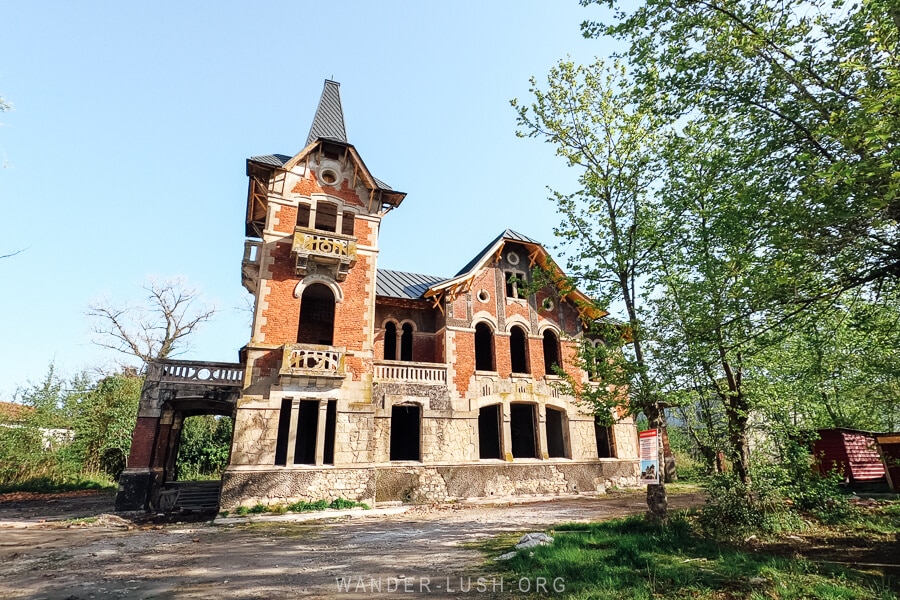
The entrance to Kolkheti National Park – part of the Colchic Wetlands, Georgia’s newest UNESCO Site – is just south of Poti. You will need to call ahead to pre-arrange a boat tour on Paliastomi Lake. Speeding across the lake and through the wetlands is an absolutely incredible experience and one of my top nature activities to do in Georgia.
→ See my Kolkheti National Park Guide for full details on how to organise your visit.

After stopping at the WWII Memorial, continue south past Maltakva Beach then turn off at Natenebi to head inland into Guria Region. I suggest overnighting near Ozurgeti (Guria’s main town), either on the farm at Komli Guest House or inside the beautiful heritage oda house at Menabde Winery.
Day 9: Guria
Distance: ~ 43 km (27 mi) | Total drive time: ~ 2 hrs return
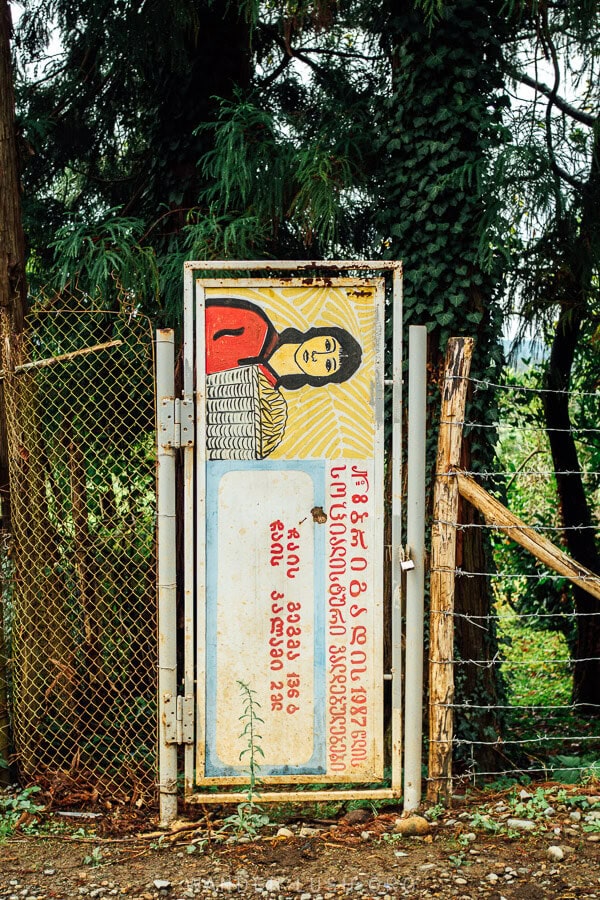

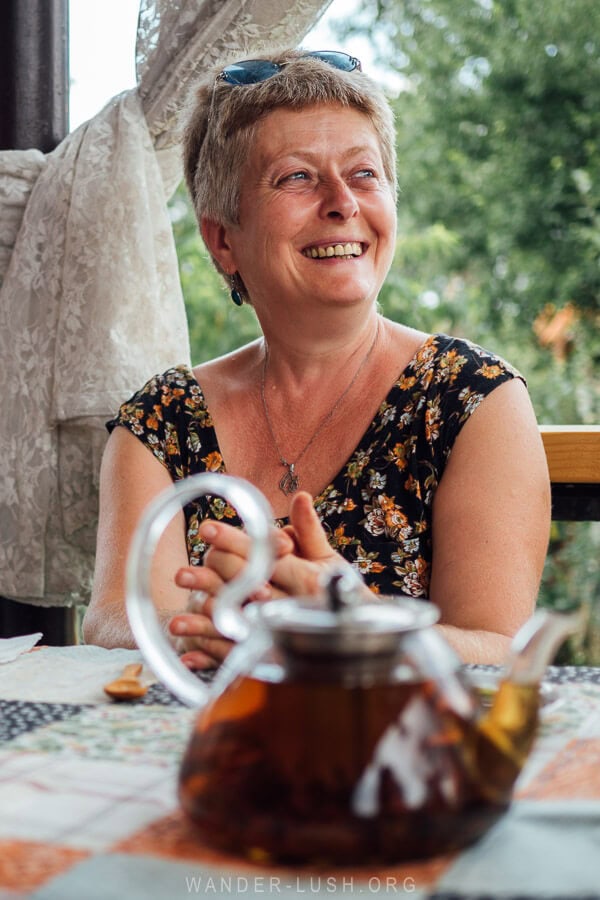
Today’s highlights:
- Tea & hazelnuts at the Ozurgeti Bazaar
- The Tea Route
- Georgian tea degustation
- Visiting the old collective plantations & tea factories in Anaseuli
- Shemokmedi Monastery & Achi Church
- Eating trout at Restaurant Achi
- Sunset at Gomismta
Both Komli and Menabde are close to Shemokmedi Monastery, so I suggest making this beautiful sanctuary your first port of call after breakfast. Day 9 is entirely dedicated to a slow-paced exploration of Guria and its tea fields, so there is no need to rush this morning.
Ozurgeti town is worth a quick stroll, particularly to visit the bazaar where you will find people selling fresh tea leaves, hazelnuts by the bagfull, and woven straw hats and baskets.


Venture out into the broad fields and undulating hills to follow Georgia’s Tea Route. Once upon a time, Soviet Georgia was one of the world’s tea producers – and much of the crop came from these collective farms. Working and abandoned tea factories, old plantations and other relics can be seen everywhere. I particularly enjoy the tea fields around Anaseuli, where the old Tropical Plants Research Centre is located.
Georgian tea degustations can be organised at Komli or at Teni Tea, another family run tea farm.
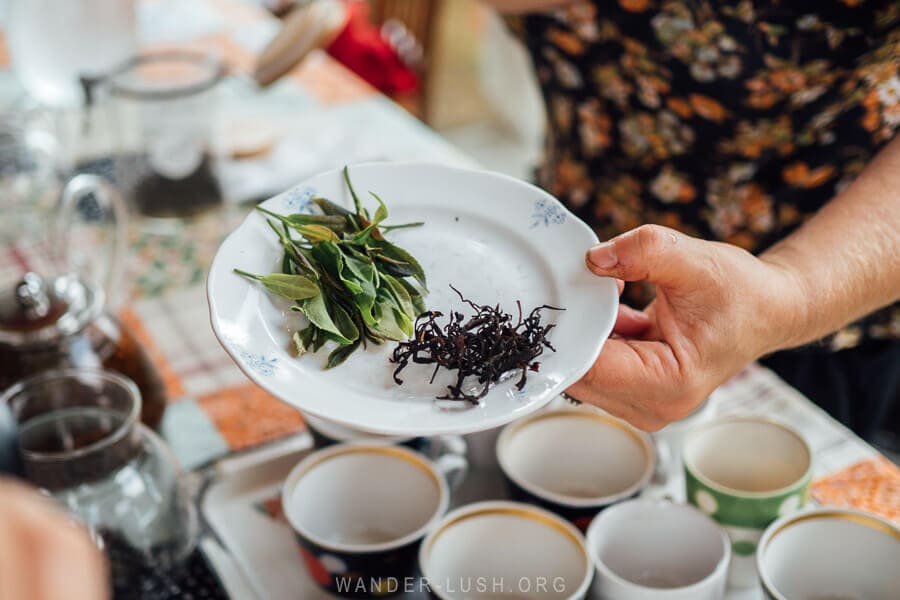
Food options are a bit limited in this area, but there is one great restaurant called Achi on the river south of Ozuregeti. It follows a popular format in Georgia, where trout are caught and cooked to order right onsite. The waterfront setting is lovely – but please remember to bring your bug spray! On the way down, stop at the little Achi Church for a look at the unique Pontius Pilate frescoes.

Guria has two mountain resorts: Gomismta and Bakhmaro. Either makes for a lovely sunset spot. I recommend Gomismta, which is closer to Ozurgeti (around 1.5 hours’ drive) and is known for its misty, moody views on account of the low-lying clouds that condense off the Black Sea. I had almost zero visibility when I visited, but I still thought it was magical.
The road is often closed for safety reasons and in summer, it only opens on weekends – so you will need to check locally whether or not you can safely get up. Be sure to leave yourself enough time so that you’re not driving down the mountain in the dark.

Return to your accommodation in Ozurgeti.
Day 10: The Black Sea Coast & Batumi
Distance: 70 km (43 mi) | Total drive time: 2 hrs plus stops



Today’s highlights:
- Soviet-era Culture Houses in Shroma & Natanebi
- Swimming on a black sand beach at Magnetiti
- Walking trails in Shekvetili Dendrological Park & Batumi Botanical Garden
- Fresh seafood on the waterfront at Taraghana Fish
- Abandoned palaces in Tsikhisdziri
- Petra Fortress
- Sunset on Batumi Boulevard
The final day of your road trip takes you back to the Black Sea Coast and all the way down to Batumi. When I drove this route, I organised to drop off my rental car in Batumi – thankfully Local Rent has reasonable one-way fees.
Once wealthy citrus-farming villages, Shroma and Natanebi are both located off the road between Ozurgeti and the coast. If you are keen to see some more Soviet-era relics, both are worth visiting – particularly Shroma, which has a well-known Culture House and Village Labour House.

The road from Ozurgeti leads you to Guria’s small slice of Black Sea coastline and the resort town of Shekvetili. Spend a couple of hours here walking the trails in the Shekvetili Dendrological Park (home to a collection of old-growth trees uprooted and transplanted by an infamous Georgian billionaire), drinking coffee at The Social Space, and visiting the Miniature Park, an outdoor museum with tiny replicas of famous Georgian landmarks. It’s a lot of fun trying to guess what’s what and picking out the buildings you’ve seen in the flesh!
A touch further north, Magnetiti Beach at Ureki is favoured for its magnetic black sands. As a general rule, the further south you go (until you pass Batumi), the more rocky and polluted the beaches get – so if you want to swim in the Black Sea, now is your chance.

From there, it is simply a matter of following the coastal highway all the way down to Batumi. I recommend stopping at Kobuleti to see the mosaics (see my Kobuleti Guide for locations) and to eat a fresh-caught seafood lunch at Taraghana Fish.
The village of Tsikhisdziri is full of decaying turn-of-the-century palaces that once belonged to Russian generals. One of them has been transformed into a hip restaurant called Shukura. The restored Roman-era ruins of Petra Fortress are worth visiting as well.
If you were taken with the tea history, try hunting down the house built for Cantonese tea expert Liu Junzhou, who came to Georgia on the invitation of a Russian merchant in 1893. It is located just off the highway in Chavki (and will be transformed into a tea museum some day soon – or so I hear!).

Before heading into Batumi city for a sunset stroll along the boulevard, you might like to stop at the Batumi Botanical Garden. It is a highlight of Batumi – both for its walking paths and for its sea views – so if you don’t have time for it now, be sure to return tomorrow.

When you arrive in Batumi, I recommend returning your car on the outskirts of the city so that you don’t have to contend with the traffic. The Railway Station is an ideal rendezvous point, as it’s one of the first landmarks you reach on entering from the north. From there, a Bolt taxi to your accommodation will only cost a couple of GEL.
For epic sea views and stylish rooms, I recommend staying at Kartuli Hotel on the New Boulevard. For something more central to the Old Boulevard and Old Town, I recommend Mariinsky Hotel.
→ For all the best things to see, do and eat in Batumi, see my Batumi City Guide.
Extend your Georgia road trip: Optional additions
Option 1: Add Mestia & Ushguli (extra 4-5 days)
If you feel confident self-driving to Svaneti, I would suggest adding Mestia and Ushguli to your itinerary after Racha-Lechkhumi. Start by cutting across to Martvili and spending a day hiking between the waterfalls and canyons along the Abasha River. Overnight at Karma Hostel.
The following day, continue via the backroads and through Zugdidi to reach Mestia. Do a day trip to Ushguli, or spend a night in the village and (road conditions permitting) resume your itinerary by driving back down to Kutaisi via the Lentekhi Pass (4WD and serious grit required). If the pass is closed, return to Kutaisi the way you came.
Option 2: Add Upper Adjara (extra 3-4 days)
Drive to the town of Khulo in mountainous Adjara from Batumi, and ride the cable car to Tago village to spend a night at Glamping Tago. If conditions are suitable, you can drive all the way through the Goderdzi Pass, through the beautiful villages and wooden mosques of Upper Adjara.
When you reach the end of the pass, head north to Abastumani and cross the Zekari Pass to reach the mineral water spa town of Sairme. Make a brief stop in Baghdati for the Vladimir Mayakovsky Museum and Cafe Glitsinia before driving into Kutaisi from the south.
Option 3: Return to Tbilisi to make it a loop (extra 1 day)
If you prefer to finish where you started, depart Batumi and use the new Rikoti Highway to travel back to Tbilisi. I suggest stopping in Gori for the Joseph Stalin Museum and the Free Walking Tour with Zhana, and at Uplistsikhe Cave City.
I hope this detailed itinerary gives you an idea of what it’s like to drive around Georgia – and helps you with planning your own Georgia road trip!
Georgia essentials
Here are the websites and services I personally use and recommend for Georgia. Check out my full list of travel resources for more tips.
FLIGHTS: Search for affordable flights to Tbilisi, Batumi or Kutaisi on Skyscanner.
TRAVEL INSURANCE: Insure your trip with HeyMondo, my preferred provider for single-trip and annual travel insurance (get 5% off when you book with my link).
SIM CARD: Magti is my preferred provider, with prices starting from 9 GEL/week for unlimited data. See this guide for all the details about buying a Georgian SIM card.
AIRPORT TRANSFERS: Most flights into Georgia arrive in the early hours. For ease, pre-book a private transfer from Tbilisi Airport to your hotel (from $17) or from Kutaisi Airport to Tbilisi (from $90) with my partners at GoTrip.ge.
ACCOMMODATION: Booking.com is the most widely used platform in Georgia. Use it to find family guesthouses, private apartments, hostels and hotels around the country.
CAR HIRE: Find a great deal on a rental car in Georgia – use the Local Rent website to book through a local agent (prices start from $20/day).
DAY TRIPS & CITY TOURS: Use Viator or Get Your Guide to browse a range of day trips and city tours. For off-beat programs, I recommend Friendly.ge (use the promocode wanderlush for 10% off). For in-depth day trips to Georgia’s wine regions, I recommend Eat This! Tours (use the promo code wanderlush for 5% off).
PRIVATE TRANSFERS: GoTrip.ge is a terrific service for booking a private professional driver and car for the day. Use it for A-to-B transfers, a customised round-trip itinerary, or a multi-day trip. You can stop wherever you like for as long as you like without the fixed price going up.
NEED SOME HELP?: Need feedback on your itinerary or personalised travel tips? I offer a one-on-one consultation call service for Tbilisi and Georgia. More information and bookings here.



